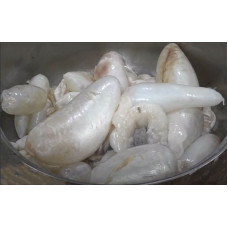Swim bladder - a peculiar bag of oblong shape (in carp fish has a transverse stretch), filled with gases, the ratio of which is constantly changing. Develops as an outgrowth of the anterior part of the intestine. In some fish, it for the duration of life, it remains connected to the intestine, in others - completely isolated. Serves as a hydrostatic organ. With its expansion or contraction changes the density of the body of fish. For some rab is an additional respiratory organ (bipedal and kysteperye fish). In most fish living on the bottom or making rapid vertical movements, the swim bladder is reduced or completely absent (shchiovka, Siberian char). There is no swim bladder and in marine fish living at great depths.
During embryonic development of bony fishes, the swim bladder arises as a dorsal outgrowth of the intestinal tube and is located under the spine. Later, the canal connecting the swim bladder to the esophagus (pneumatic canal) may disappear. Depending on the presence or absence of such a channel fish are divided into open and closed-bellied fish. In open-bellied fish (physostome) swim bladder throughout life is connected with the intestine air duct, through which gases enter and exit inside. Such fish can ingest air and thus control the volume of the swim bladder. Open-bellied fish include carp, herring, sturgeon, and others. In adult closed-bellied fish (physoclists), the air duct becomes overgrown, and gases are released and absorbed through the red body, a dense plexus of blood capillaries on the inner wall of the swim bladder.
The main function of the swim bladder is to provide zero buoyancy: it compensates for the weight of bones and other heavy body parts and brings the average density of the body closer to that of water. As a result, fish do not need to expend energy to maintain their bodies at the desired depth (whereas sharks, which do not have a swim bladder, have to maintain their diving depth by constant active movement). The compressibility of the gas makes the equilibrium unstable: as the fish dives, the water pressure increases, the bubble shrinks and the fish sinks even further; similarly, when surfacing, the bubble expands and the fish is pushed to the surface. To prevent this, the fish body regulates the amount of gas in the bubble by gas glands (dense clusters of capillaries), where the blood releases or absorbs oxygen. Fish capable of rapid vertical movements do not have a bubble, because this regulation would not have time to adjust to changes in pressure and rapid surfacing, blowing the bubble could be dangerous.
The swim bladder is located at the very top of the abdomen, but is still always below the center of mass of the body. This creates an overturning moment, which the fish has to counteract by moving its pectoral fins, and the dead fish turns upside down.
One of the common features of bony fishes of the superorder of bony-bellied fishes that make up the majority of modern freshwater fishes (gonorhynchiformes, carpiformes, characiniformes, catfishes, gymnotiformes) is the presence of the weber apparatus - a system of bones connecting the swim bladder with the inner ear. This makes it possible for the ear to perceive vibrations picked up by the bladder.
Some fish with the help of the swim bladder make sounds (batrachovyh - with a force of more than 100 decibels).
Swim bladder
Tags: swim bladder

